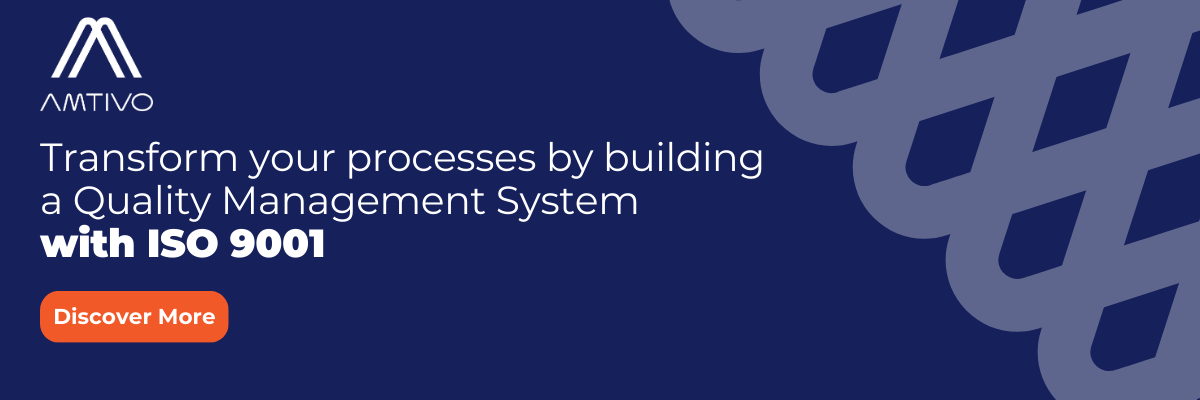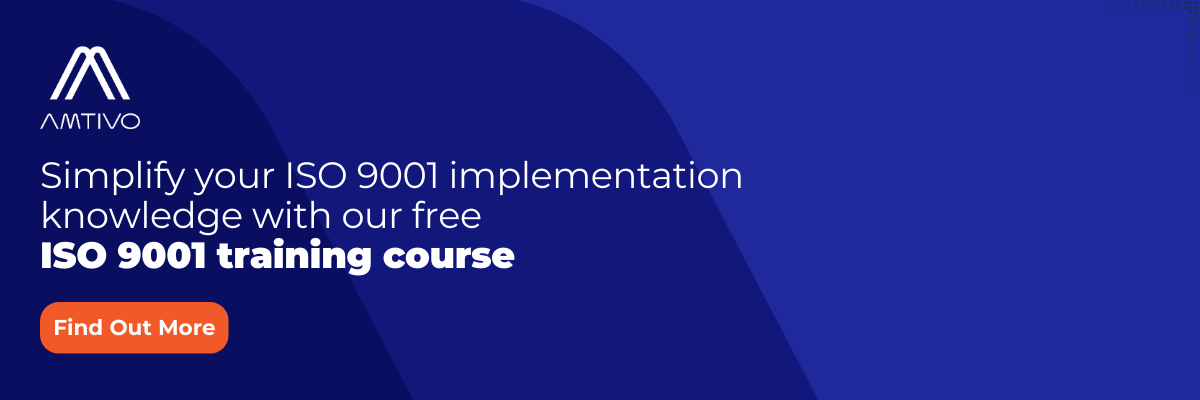A Quality Management System (QMS) can be an essential part of everyday operations for businesses that want to boost product quality and efficiency.
It gives you a straightforward way to maintain high quality in everything you do while helping you deliver products and services that comply with industry regulations. Implementing internationally recognized standards like ISO 9001 or IATF 16949 can further enhance these efforts by providing a structured management system for quality management.
If you’re keen to keep your organization evolving and improving, an efficient QMS can be a powerful tool to help drive growth.
So, what do you need to know about QMS implementation? This article outlines typical steps and considerations commonly involved in the establishment of a Quality Management System (QMS).

Step-by-Step Guide for QMS Implementation
1. Define and map your processes
Defining and mapping processes is often considered a foundational step in QMS development, as it lays the groundwork for system design. This typically involves reviewing the organization as a whole and examining how each operation connects. In doing so, many organizations identify inefficiencies or constraints that may be affecting performance.
Visual tools such as process maps and flowcharts are commonly used at this stage. These representations help clarify how steps interact and can support better communication across teams.
2. Define your quality policy
A clearly defined quality policy supports an organization’s commitment to quality and is intended to reflect its mission and values. It acts as a reference point for quality efforts and helps provide clarity around expectations across the business.
For organizations working toward ISO 9001 certification, the quality policy is expected to demonstrate alignment with customer satisfaction and regulatory requirements.
For example, a quality policy might state, “We are committed to delivering products that meet or exceed customer expectations and comply with industry standards.” Each organization will typically tailor their policy to reflect their unique goals and context.
Read our guide on how to write an ISO 9001 quality policy.
3. Define your quality objectives
Quality objectives represent measurable goals related to quality performance and are typically aligned with wider business strategy. These objectives help track and maintain progress in key areas of focus.
Depending on the organization’s size and scope, objectives may relate to compliance, operational efficiency, or customer satisfaction. For instance, a manufacturing company may aim to improve on-time delivery rates, while a food producer may set objectives for reducing waste over a defined period.
Regular reviews help ensure objectives remain relevant and support engagement across teams.
Want to know more about Quality Management? Read: The 7 Principles of Quality Management.
4. Develop metrics to track CSF data
Many organizations identify Critical Success Factors (CSFs) that are vital to achieving strategic aims. To evaluate these, metrics may be developed to provide data-driven insight. These are typically used to monitor progress and support evidence-based decision-making.
Examples of such metrics include defect reduction rate or on-time delivery, which can indicate how operational performance aligns with quality-related goals.
5. Identify potential defects within each process
Identifying potential defects in processes can support efforts to meet quality expectations and manage risk. A defect refers to a deviation from expected outcomes that could affect product or service quality. Understanding where and why these occur can inform corrective actions.
In sectors such as medical devices (e.g., ISO 13485), addressing defects is an essential part of maintaining product safety and compliance.
Once issues are identified, actions such as reviewing procedures or adjusting training programmes may help reduce recurrence.
6. Create documents and records
Documented information forms a key part of an effective QMS. Common practice includes recording procedures, policies, and standards to support clarity of roles and responsibilities. These records also assist with training, compliance, and internal audits.
Typical QMS documents include a Quality Manual, Standard Operating Procedures (SOPs), Work Instructions, Quality Policy, Process Maps, and Internal Audit Reports. Maintaining this documentation supports consistent practices and informed decision-making.
7. Define quality processes
Establishing processes such as internal audits, corrective actions, and management reviews is a central part of quality management. These processes provide assurance that operations continue to meet intended outcomes and offer a mechanism for identifying improvement opportunities.
Effective communication also plays a role by ensuring staff are informed about quality objectives, updates, and audit results. Together, these elements help ensure the QMS remains effective and continually improves.
Discover more about corrective and preventive actions and how they work in an ISO 9001 QMS.
8. Determine training needs
Organizations often review training needs as part of QMS development. This may involve assessing current skills and identifying areas where further training would support quality objectives.
For example, staff may need awareness training on ISO 9001, internal audit practices, or data interpretation. Ongoing learning helps maintain competency and can encourage broader engagement with the QMS.
9. Integrate the QMS into daily operations
For a QMS to be fully effective, it is typically integrated into daily workflows and decision-making, thus providing many benefits. This includes applying QMS principles consistently across functions, with leadership playing a key role in supporting alignment with organizational goals.
Embedding a culture of continual improvement also supports the system’s effectiveness. Feedback mechanisms and review cycles are often used to identify where changes may be needed, helping to keep the QMS responsive and relevant.
Learn about the role of customer feedback in quality management.
10. Measure, monitor, and improve performance
Monitoring performance allows organizations to assess how well their QMS is functioning. Data may be used to verify whether objectives are being met and to identify opportunities for improvement.
Periodic reviews and trend analysis can help inform future planning. For example, if data shows high levels of waste or rework, this might prompt targeted initiatives aimed at efficiency or customer satisfaction.
Tools for QMS
The following tools are typically used in QMS implementation to help organizations meet the requirements of various ISO standards through effective management, control, and continual improvement of quality processes.
Process maps and flowcharts
What are they? Visual tools to depict the sequence of steps in a process, helping to identify bottlenecks and streamline operations.
How do they work? These tools provide clarity on how different operations interact, making it easier to optimize processes. In ISO 9001, process maps support the approach by promoting efficiency and alignment with quality objectives.
Failure Modes and Effects Analysis (FMEA)
What is it? A systematic method for identifying potential failures in a process and assessing their impact.
How does it work? FMEA helps businesses prioritize risks based on their severity, occurrence, and detection so they can be mitigated. In ISO 13485 for medical devices, FMEA is often used as part of risk management to support product safety and reliability.
Control charts
What are they? Statistical tools used to monitor and control process performance over time.
How do they work? By plotting data, control charts help identify variations and trends, signaling when a process is out of control.
Checklists
What are they? Simple lists that help to check that all necessary steps are completed.
How do they work? Checklists help maintain consistency and reduce errors, especially in complex or repetitive tasks. They are used in various ISO standards for QMS to promote consistency and compliance with processes.
Root Cause Analysis (RCA)
What is it? A method for identifying the underlying causes of a problem or defect.
How does it work? By analyzing the root cause, organizations can implement corrective actions to prevent problems from occurring again.
Statistical Process Control (SPC)
What is it? A method involving statistical techniques to monitor and control a process.
How does it work? SPC analyzes data from production processes to spot variations that could affect quality. In IATF 16949 for the automotive industry, SPC is used to deliver high-quality standards in manufacturing processes.
Avoid issues when implementing your QMS. Read our guide to the 7 common ISO 9001 implementation mistakes.
Ready to Start Your QMS Implementation?
Effective implementation of a QMS is often supported by strong leadership and a culture of quality. Engaging personnel at all levels helps sustain and improve system performance over time.
Get started on your journey to certification—get a quote today or contact our team of experts to our certification services.







